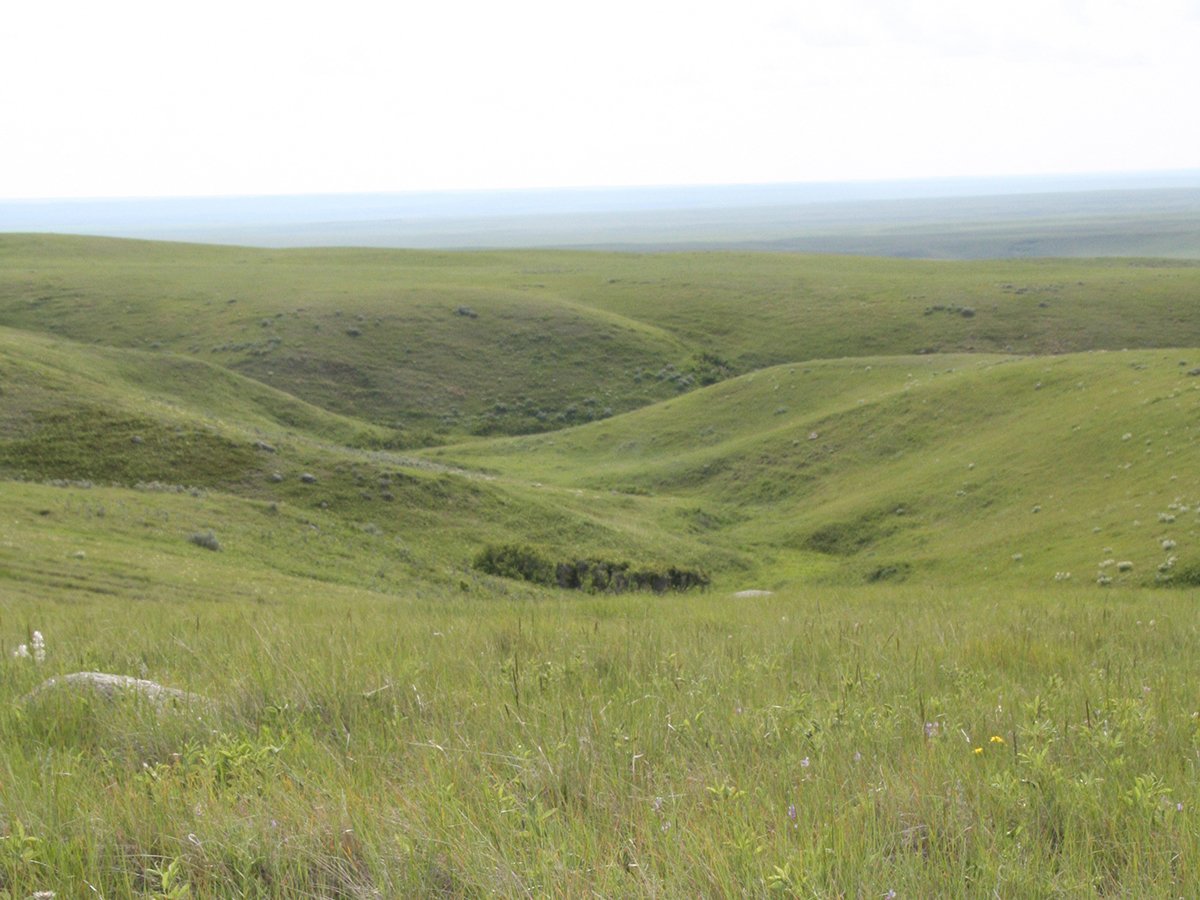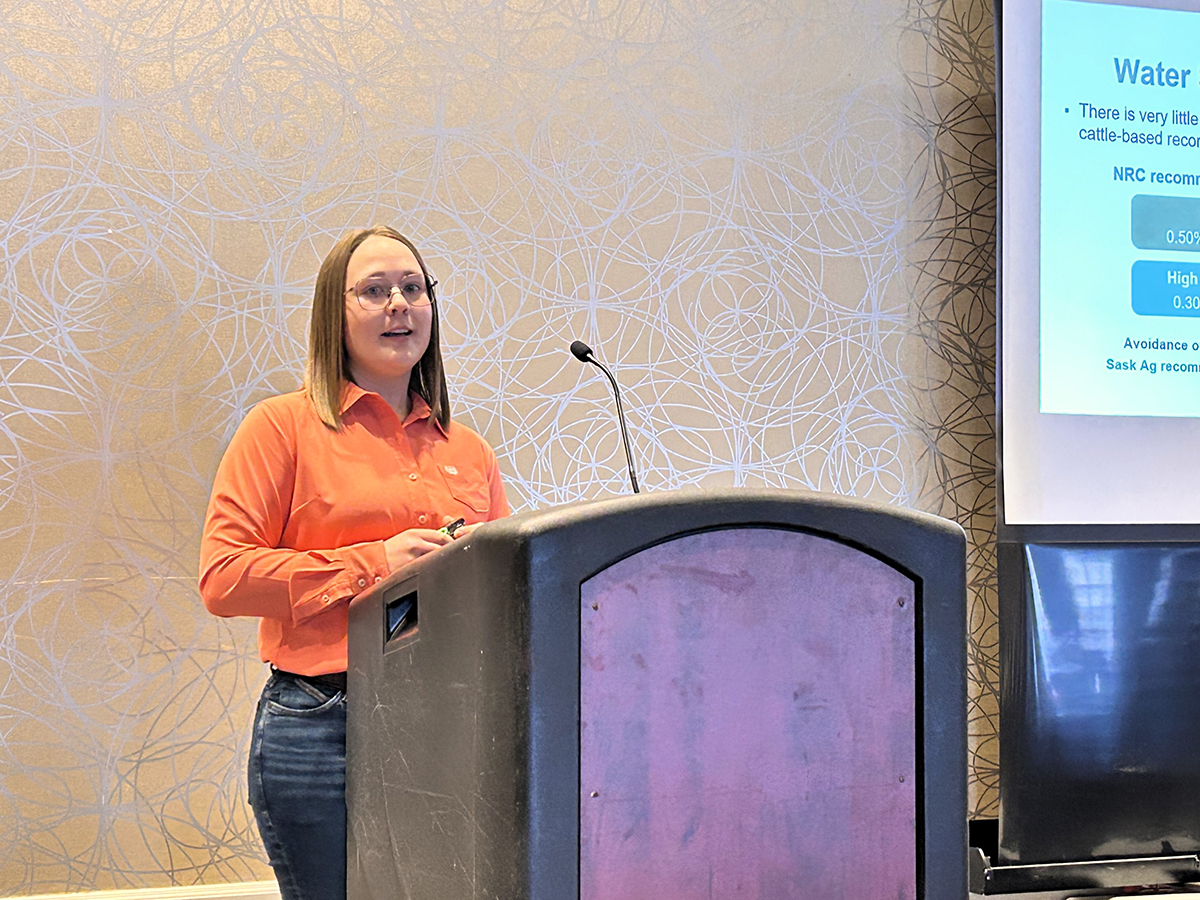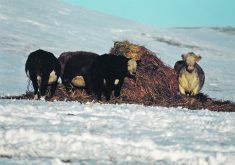SASKATOON — Copper toxicity, sulphur toxicity, thiamine deficiency and contaminated water are all linked together. They play on each other and can wreak havoc on livestock herd health.
Jordan Johnson, a University of Saskatchewan grad student working on her PhD in animal science, shared the importance of water quality and testing with those attending the Saskatchewan Sheep Symposium Jan. 10.
Johnson’s PhD project is aimed at researching the impacts of high sulphate water for cattle and sheep.
Read Also

Alberta irrigation project on grasslands approved
Environmental concerns raised by Alberta conservation groups over irrigation expansion project within rural municipality
Livestock producers in Saskatchewan are aware of the need for good, clean water for their animals. However, what they might not realize is that Saskatchewan, and other areas of the northern Great Plains such as Alberta and western Manitoba, have some of the highest sulphate quantities.
According to Saskatchewan Agriculture data, there have been increases in water quality issues in recent years.
“There’s some data from the Ministry of Agriculture through their livestock water testing that shows that a good proportion of water sources in Saskatchewan actually don’t meet guidelines established for livestock drinking standards,” Johnson said.
“So, it’s not uncommon for us to come across water sources that are too high in sulphate for livestock.”
Johnson said this is partly because of the drought conditions experienced in the last few years. Water evaporation causes greater concentrations of mineral solids or salts, so when water does come through with spring runoff or heavy rain, those solids rise to the top of the water and are consumed by livestock.
The effects of too much sulphate can be severe for sheep and cattle, resulting in Polio encephalomalacia.
Veterinarians may refer to polio as cerebrocortical necrosis, and some producers may be familiar with the symptoms but not the name.
Symptoms include head pressing, poor muscle control, cortical blindness and loss of control of eye movement.
High concentrations of sulphur lower the pH of an animal’s digestive rumen, and lower rumen pH allows higher production of hydrogen sulphide gas.
“Sulphur consumed in the diet, as sulphur in feed or sulphate in water, is absorbed or consumed into the rumen. And where it meets the rumen, from there, it’s reduced from sulphate, or elemental sulphur, through a series of steps to sulphide.”
Sulphide is a gas that builds up within the animal’s digestive system, which is released by “ruminating” or burping. When this gas is burped and exhaled, it’s then inhaled by the animal and infiltrates the lungs.
The lungs are a gateway to the blood, where the sulphide can then cross the blood-brain barrier and interfere with the brain’s energy production and cause the symptoms of polio.
“More water sulphur, more dietary sulphur, low rumen pH all increase (the) risk for polio,” Johnson said.
Polio can be caused by high sulphate levels, but also by thiamine deficiency. However, there is a relationship between the two causes.
Johnson said low rumen pH also reduces an animal’s ability to synthesize thiamine. It is an essential nutrient for energy production in the brain because it assists in the synthesis of glucose, the brain’s preferred energy source.
The lowered rumen pH also produces thiaminase, an enzyme that breaks done thiamine and further reduces the animal’s ability to absorb thiamine before it’s broken down.
“So, it’s kind of a multi-faceted issue here for sheep, where perhaps they have high sulphur, but they also are experiencing thiamine deficiency, which can lead to polio as well. It’s possible that these two factors could be at play at the same time.”
The main resolution to polio is thiamine supplementation.
Johnson additionally believes that thiamine deficiency is a greater cause of polio in sheep than high sulphur. She says the reason for this is the transition period during weaning because milk is high in thiamine.
This means that during weaning, there is a “lag phase” because lambs aren’t yet using their own rumen to produce the vitamins. However, they’re no longer receiving it from their mother’s milk either, creating a risk period.
High sulphate can create additional risks, aside from polio. It interferes with other essential minerals for livestock, such as copper. This interference can occur in a few different ways.
When the compound molybdenum is combined with sulphate, it can bind to copper and form thiomolybdate. This combination is irreversible, and it makes copper unavailable to the animal.
The other combination includes iron, which is found in high levels in Saskatchewan forage and some water supplies.
“To make this kind of a bigger issue in Western Canada, iron, sulphur and copper can also combine to create complexes and reduce copper available for absorption.”
In a study at the Livestock and Forage Centre of Excellence, Johnson worked with a control group and two test groups. The control received 350 milligrams of sulphate per litre of water, and the test groups received 3,000 mg and 6,000 mg per litre, respectively.
Liver tests found a decrease in copper by nearly half compared to the control group during the 100-day feeding period. Liver tests were used because blood tests can often be misleading — deficiency won’t show until it’s quite high.
Copper is needed for many physiological functions: cellular energy production, immune functions and immunoglobulins and white blood cell production.
It’s also important for melanin pigment production and bone and collagen formation and contributes to the proteins that form lung, skin and blood vessels, as well as ligaments and tendons.
“When copper is low, we actually see an enzyme impairment that ends up kind of producing a lot of the symptoms that we observe, so it’s really important, and it’s an important enzyme, and that enzyme influences a lot of development or pathways throughout the body.”
Symptoms of copper deficiency in sheep can be seen as changes in wool colour and texture, impaired bone development, swayback and neurological issues.
There’s strong data of high copper deficiency among cattle in Western Canada, but not a lot on sheep. However, she said she’s recently heard of incidences in Manitoba. The cause could be more molybdenum in Manitoba than in Saskatchewan.

Copper is also important for reproduction.
“There are several very strong studies that demonstrate that reducing copper status in beef cattle exponentially increases the risk of reproductive failure, and those pathways function the same in sheep as well. We just don’t have work demonstrating that yet.”
In lambs, the most common symptom of deficiency is swayback or enzootic ataxia.
“It actually ends up being a neurological dysfunction issue in lambs, and that can present right at birth, or usually six weeks after birth, and they kind of end up having it’s almost paralyzed their hind end looks a little a little funky.”
Mitigation of issues
Johnson offered some options to address current issues a producer may be facing or to eliminate future issues relating to sulphur, copper and thiamine.
The best option, according to the research, is a reverse osmosis water system for livestock. However, she recognizes that this has its own challenges, noting the cost, power requirements, the need for an additional building and dealing with waste water.
While this may be easier for sheep because they require less water per head than cattle, it does require a thorough plan and a few extra dollars and can be a bit impractical.
Her more practical options, likely to appeal to most producers, are simpler. She recommends hauling fresh water to the animals, hauling animals to a new water source or simply adjusting the time of year when animals are on certain sections of land.
“(Another option) is to substitute that inorganic copper, often in the off-the-shelf mineral, with a chelated or hydroxy traced mineral.… We base this recommendation on the fact that chelated or hydroxy traced minerals actually can bypass the rumen.”
There’s research showing these types of minerals have higher bioavailability to animals and can increase trace mineral status. It’s important to note that supplementing copper sulphate or copper oxide does not produce these results.
Johnson discovered this herself during a study in which she gave cattle three times the recommended rate of copper in the forms of copper sulphate and copper oxide. The animals were on feed for 12 weeks and received 3,200 mg per litre.
“Even though we gave some of them three times the amount of copper they’re supposed to have, we saw no improvement in copper status. They performed just as equivalent as those that got the recommended amount.
“So, what this kind of suggested to us is that increasing the amount of copper isn’t going to solve the problem and that the antagonism is the primary issue that’s driving this.”
A study planned for this spring will see if a chelated copper source produces different results. Johnson hopes to see that it bypasses the rumen and improves trace minerals.


















